|

CHARLES BURNETT III -
Born in England in 1956, Charles Burnett was educated in South Africa and the United States. As a legitimate tri-national - his mother was Canadian and his father American - he inherited a love for travel and all things mechanical from his father, who raced hydroplanes and restored Hudson automobiles.
A long-time powerboat enthusiast, Charles set up Vulture Ventures, a UK-based offshore racing team, which soon became known as the world’s most successful team in the sport. During this time, Charles took a variety of world records using catamarans and monohulls powered by diesel, petrol and LPG. He was included in the Guinness Book of World Records in 1999 for an offshore water speed record of 137mph.
Since then, Charles has been looking at ways of advancing environmentally friendly vehicles on land, water and in the air without sacrificing the "fun quotient"
or sales potential.
DAILY
MAIL - 27 AUGUST 2009
A British-built steam car has smashed a 103-year-old world land speed record for steam-powered vehicles in the
United
States.
The 25ft-long British Steam Car - nicknamed the 'fastest kettle in the world' - reached an average speed of 139.843mph on two runs over a measured mile at the Edwards Air Force Base in California.
Driver Charles Burnett beat the previous record of 127mph set by American Fred Marriott in a Stanley steam car at the
Daytona Beach Road Course in 1906.
Mr Burnett is quoted as saying: "It was absolutely fantastic. I enjoyed every moment of it.
We reached nearly 140mph on the first run before I applied the parachute.
The second run went even better and we clocked a speed in excess of 150mph. The car really did handle beautifully."
The new international record, which is subject to official confirmation by officials from the Federation Internationale de l'Automobile
(FIA), followed a series of cancellations in the past week due to technical difficulties and bad weather.

In
the workshop, a scale model, compared to the full size buck, used to
make the body panels and develop the design concept.
Mr Burnett piloted the car for both runs, reaching a peak speed of 136mph on the first and 151mph on the second, a team spokesman said.
Record officials recognise a land speed record as the average speed of two passes made across the same measured distance in opposing directions within 60 minutes of each other.
Mr Burnett is a nephew of Lord Montague of Beaulieu, who made it into the Guinness Book of World Records in 1999 for an offshore water speed record of 137mph.
Other members of the team, based in Lymington, Hampshire, included 48-year-old test driver and father-of-two
Don
Wales, nephew of the late speed ace Donald Campbell and grandson of
Sir Malcolm Campbell.
Weighing three tons, the British Steam Car is made from a mixture of lightweight carbon-fibre composite and aluminium wrapped around a steel space frame chassis.
It burns Liquid Petroleum Gas (LPG) in 12 boilers containing nearly two miles of tubing.
Demineralised water is pumped into the boilers at up to 50 litres a minute to cool the blistering burners, which produce three megawatts of heat.
Steam is superheated to 400C and injected into the turbine at more than twice the speed of sound.
The car is brought to a stop by large Goodyear
tyres, brake discs and a parachute.
Project manager Matt Candy said the team turned the car around for its second run with just eight minutes to spare before they would have breached FIA rules.
An overjoyed Mr Candy said: 'The first run took place at 7.27am (local time) when the air temperature was a cool 63 degrees.
'The team turned around the car in 52 minutes, with just eight minutes to spare in preparation for its return run.
'The British Steam Car takes 2.5 miles to accelerate and after the measured mile, a further 2.5 miles to decelerate, so each run was over 6.5 miles.
"The FIA requires that the return run takes place within 60 minutes.
Compared to the testing we did in Britain, the British Steam Car ran 12 times the distance and twice the maximum speed - all within one hour.
It's been a huge challenge for all."
Watching the triumph in the Mojave Desert was Pam Swanston, wife of the team's late project manager Frank Swanston.
She said: 'If only Frank was here today. It was his vision that made it a reality. He would be incredibly proud of the team's achievements and always believed we would succeed.
'Today we celebrate this record for Frank.'
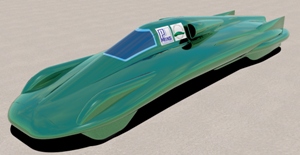
Artist's
impression of the British
LSR Steam Car in 2004
Although the team broke the official world land speed record for a steam-powered vehicle, their efforts fell short of an unofficial record set in 1985.
The Barber-Nicholls team reached a speed of 145mph in their vehicle, Steamin' Demon, but no attempt was made to have it officially recognised by the FIA.
Before the attempt in California, officials from the British Steam Car said they acknowledged the 1985 attempt as the record to exceed.
A spokesman for the British team said they intended to stay on in California in an effort to emulate the Barber-Nicholls speed.
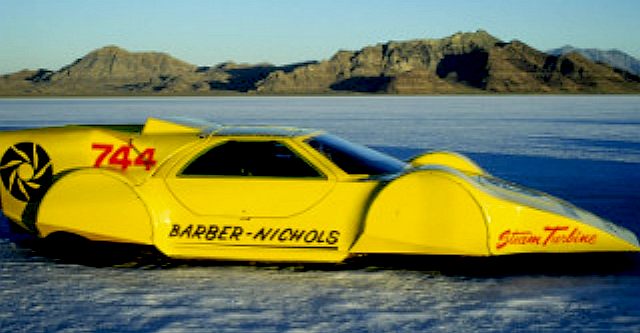
STEAMIN
DEMON - In 1985, a steam turbine-powered vehicle modified and driven by Bob Barber set a new Land Steam Record of 145.607 MPH at the Bonneville
Salt Flats. However, this record was not recognized by the
F.I.A as official, since the Barber vehicle set the record running two timed runs in the same direction. The F.I.A requires that timed runs be made in both directions, within one hour, with the average speed of the two runs becoming the record speed.
This is still the speed to beat, unofficial or not.
DAILY
MAIL - 25 DECEMBER 2010
If you believed the golden age of steam was in the dim and distant past, think again.
This streamlined British supercar that went on a test run at a military airstrip near Chichester last week is about to attempt to smash one of the world's most enduring records, the highest speed for a steam-driven car.
Known as the 'World's Fastest Kettle', the car is being shipped to America where driver Charles Burnett III will make the record attempt across a dried-up lake bed in the Mojave Desert of Southern California in early June.
The steam-car record of 127.659mph was set by American Fred Marriott in 1906 in a machine called the Stanley Steamer.
He tried to break his record a year later but the car hit a rut, flew into the air and shattered when it hit the ground. Marriott was injured and did not make another attempt.
His landmark has remained unchallenged ever since and is the longest-standing officially recognised speed record.
In the early 1900s, steam cars far outsold petrol-driven vehicles because they were faster and more reliable.
But by the time the Stanley Motor Carriage Company ceased operation in 1924, the internal combustion engine had far eclipsed steam technology and the $3,950
Stanley Steamer cost almost eight times as much as the
best-selling Ford Model T.
The new car bears little resemblance to the Stanley Steamer. It is made of a mixture of lightweight
carbon-fibre composite and aluminium wrapped round a steel chassis and took ten years to develop.
Despite its modern composite construction, the 25ft-long 'Kettle' weighs three tons. The sleek bodywork contains 12 boilers with almost two miles of thin metal tubing.
Up to 50 litres per minute of demineralised water is pumped into the boilers and superheated to 400C by burners fuelled by Liquid
Petroleum Gas.
The resultant steam is injected into a turbine at more than twice the speed of sound. The turbine shaft drives the car at a speed the designers hope will exceed 170mph. The driver deploys a parachute to help the brakes stop the car.
The picture shows the second of the Kettle's two test runs at the Ministry of Defence runway at Thorney Island, near Chichester, West Sussex, last week.
Behind the wheel was Don Wales, the 48-year-old nephew of British speed legend Donald Campbell and grandson of Sir
Malcolm Campbell, who also broke land and water records.
Wales said: 'The car is so powerful, you can feel the immense force of it. It was just itching to get away.'
However, Charles Burnett III, nephew of Lord Montagu of Beaulieu, who founded the National Motor Museum in the New Forest, will drive the car in the record attempt at Rogers Dry Lake Bed, near Edwards Air Force Base in
California.
Burnett is already in the Guinness Book Of World Records after setting an offshore water speed record of 137mph ten years ago.

INSIDE THE COCKPIT
1. Button to switch on the power, after which it shines green.
2. Tachometer shows turbine speed in revolutions per minute.
3. Brake temperature warning light. Comes on if the brake pads exceed 800C.
4. Warning lights working with the satellite navigation system to show if the car is drifting off track and direct the driver left or right.
5. Alternator charger light which comes on when the car is not moving, or warns if the alternator stops working.
6. Water level warning, which lights up if the water tanks are less than ten per cent full.
7. Speedometer, connected to a sensor on the front right wheel.
8. Tyre pressure light which shows if the pressure in the Goodyear tyres drops below 65 pounds per square inch.
9. Steering wheel shaft where the rod is inserted. The wheel is red and has two buttons, the left one to transmit by
radio.
10. The right button is covered and operates the parachute.
11. Handle used to open the cockpit.
Driver Don Wales carried a St Christopher pendant and a sovereign coin inscribed 'To Daddy, love Jean' during the Kettle's test runs.
The inscription was a message from his mother to her father, Sir Malcolm Campbell, who became world famous in the Twenties and Thirties by breaking the world speed record on
land and water a total of 13 times in a series of vehicles named Bluebird.
Sir Malcolm became the first man to drive a car at more than 300mph when he set his final land speed record at
Bonneville Salt Flats in Utah in 1935. He died following a stroke in 1948, aged 63.
His son Donald, Wales's uncle, set eight world speed records, including topping 400mph at dried-up
Lake Eyre in Australia in 1964.
He was killed at Coniston Water in the Lake District in January 1967 while attempting to break his water speed record of 276.33mph in his Bluebird.

DESIGN
The
car is rear engined with rear wheel drive. All four wheels are mounted on double wishbone independent suspension, with rack and pinion steering on the front
wheels, so fairly conventional. The braking system comprises disk brakes on all four wheels and a parachute.
The chassis is a cross-braced double ladder space frame made from square section aircraft specification steel tube with a bulkhead between the driver and the
powertrain. The body shell from the bulkhead forwards is carbon composite, while the rear panels are in
aluminium.
SPECIFICATIONS
Dimensions
|
Overall
length
|
5.25
m
|
Wheelbase
|
3.80
m
|
|
Overall
width
|
1.70
m
|
Front
wheeltrack
|
1.22
m
|
|
Overall
height
|
1.10
m
|
Rear
wheeltrack
|
1.30
m
|
|
Frontal
area
|
1.1
sq.m
|
Drag
coefficient
|
0.20
|
Construction
Tubular
steel spaceframe with carbon composite front/aluminium rear
panels
Tyres
|
Front
|
Goodyear
L.S.R. - 270 mm rolling rad. X 140 mm width
|
|
Rear
|
Goodyear
L.S.R. - 211 mm rolling rad X 165 mm width
|
Suspension
Independent
all round.
Coil springs and integrated shock absorbers.
Steering
Rack
and pinion.
Brakes
Twin
front wheel disk brakes, twin rear inboard rear disc brakes,
braking parachute.
Engine
Two
stage Curtis type turbine.
Output: 325 b.h.p.
Output
shaft gear ratio: 5:1
Differential: Epicyclic type with viscous couplings.
Boiler
Four
independent boilers of straight water tube type.
Fuel
L.P.G.
(Liquefied petroleum gas).
Working
fluid
Water/steam
Design
performance
Maximum
speed 200+m.p.h.
Initial acceleration: 0.52g
|

THE
TEAM:
Driver
- Charles
Burnett
Lady
Driver - Annette
Getty
Chief
Designer - Glynne
Bowsher
Consulting
Engineer - Peter
Candy
Systems
Design - Jeremy
Bliss
Internet
- Jeremy Davey
LPG
System Designer - John
King
Project
Instigator - Dr.
Neil Richardson
Engineering
Logistics Coordinator - Frank
Swanston
Team
Coordinator and Administrator - Lynne
Angel
Senior
Test and Car Build Technician - Shaun
Arnold
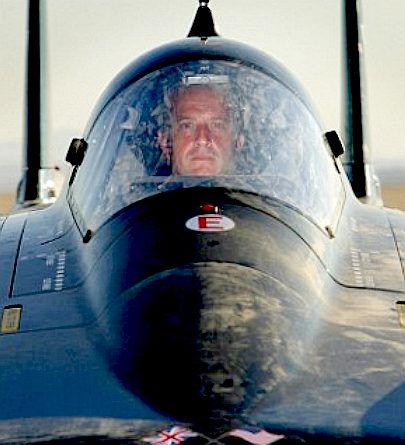
STEAM
CAR LINKS:

The Stanley Brothers built their first steam-powered car in Watertown, Massachusetts in 1897. Within a
decade they created the 'Fastest Car in the World' - the Stanley Rocket.
F. Stanley led the project, completing the design, build and test work in 1905. The
car (replica shown above) made its public debut on Ormond Beach in January 1906.
The Stanley brothers chose Fred Marriott, a daredevil pilot, to drive their car. The first day on the sand the car won the Dewar
Trophy and set a record in the one-mile steam championship. The next day he set a record in a five-mile open race. On January 26th, Marriott set a one-kilometer record at 121.6 mph, the first person to traverse two miles in less than a minute. Two hours later, he upped it to 127.7, a record which lasted until 1910.
In 1907, the Stanley's returned with a more powerful Rocket. However, a combination of poor beach conditions and a partial boycott thinned the competition. Undaunted, the improved Rocket hit a top speed of 150 mph just prior to hitting a depression in the sand which destroyed the car and sent its boiler rolling into the surf. Marriott was injured but vowed to return. He did not; the rules were changed to exclude short distance steam cars and the Stanley Brothers decided the speeds were too risky for their
pilot. Neither the brothers nor Fred Marriott returned to Ormond Beach again.
LINKS
& REFERENCE
Cyclone
Power
Steam
Speed America
US
Land Steam Record
Wikipedia
Stanley_Motor_Carriage_Company
Steam
Car LSR
Wikipedia
Steam_car
OIC
Inc museum
1977_steamin_demon
The
Guardian 2009 steam powered car speed record
Daily
Mail The British supercar thats known as the fastest kettle in the world
http://www.theguardian.com/technology/2009/aug/26/steam-powered-car-speed-record
http://www.oiccam.com/reno/car_museum/racecars/1977_steamin_demon.shtml
http://en.wikipedia.org/wiki/Steam_car
http://www.steamcar.net/lsr.html
http://www.cyclonepower.com/
http://www.steamspeedamerica.com/index.html
http://www.uslandsteamrecord.com/
http://en.wikipedia.org/wiki/Stanley_Motor_Carriage_Company
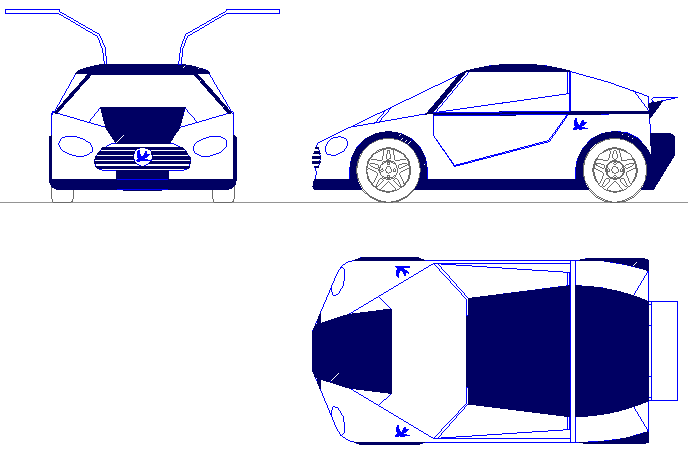
Team
Speedace plan to run the Ecostar
DC50 above on the from John O'Groats in Scotland to Lands End in Cornwall in an attempt to
beat the current record set in a Tesla
in 2013. Contact Chris or Terry for
details. Donald Campbell would have loved to see the blue bird logo on a
road car. This is a fitting tribute to the speed king on the 50th anniversary
of his land (16-7-64) and water (31-12-64) speed double whammies in
the same year.
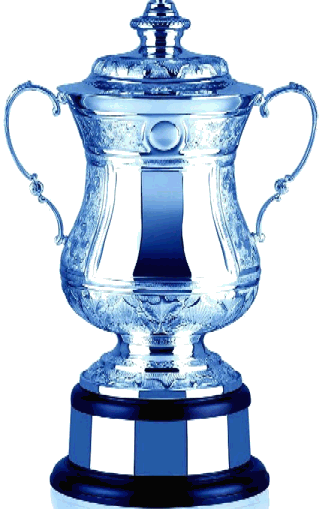
The
Bluebird World Cup Trophy challenge
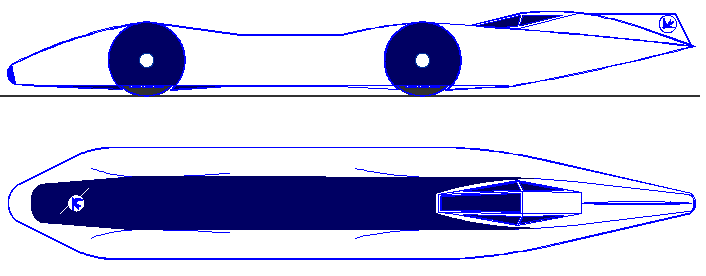
The
blue bird
legend continues with this
beautiful Reid Railton inspired
design, with input from CN7
designer Ken
Norris as to layout, drive configuration and materials. The BE3 is
potentially the
world's fastest electric car: 350mph + using energy from nature.
Featuring built in Bluebird™ battery cartridge exchange, charged using renewable
solar energy. Sponsors sought for the 2016 season.
|